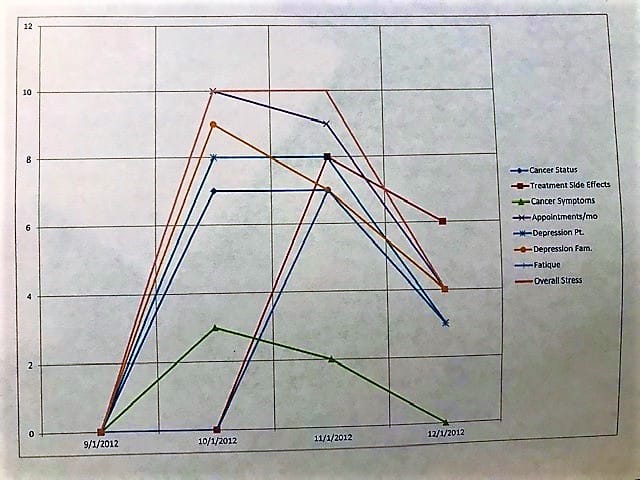
I recently decided to reframe the problem of explaining what it’s like to live with cancer, by creating a complicated graph. In January, we had a crazy week, down at the Mayo Clinic. We had gone thinking my husband would be in a new trial. Then, the doctors discovered what they thought were more brain metastases. These would disqualify him from the trial. So, they cancelled his biopsy and other testing appointments.
Meanwhile, the polar vortex hit Minnesota plunging temperatures to record lows. It was so cold that a man died in the very town where we were staying because he got locked out of his house. Our car wouldn’t start. We had to depend on a stranger to get us to the clinic for Dan’s appointment. She was amazing.
Then, a neurologist examined the MRI’s of Dan’s brain and decided the increased size was “bloom,” something that happens a couple of months after radiation treatment. But, we would have to reschedule all of Dan’s appointments.
The Concept of the Line Graph
Our emotions were on a rollercoaster. I wondered if other people realized that this is sort of what life is like when you are living with cancer. As a public educator, I thought about how to reframe the problem, to help people visualize this. Could I graph it?
I decided it would be best to show several of the factors which comprise how we’re doing. I say “we,” because people don’t have cancer in a vacuum. These factors I focused on to reframe the problem include:
· Cancer Status
- This is what we know because of a scan result, explained by the doctor. There are times when the cancer is bad, but we don’t know it, and times when it has improved due to treatment or other factors, but we don’t yet know it. The position on the graph will reflect what we KNOW for sure, when we know it.
· Cancer Symptoms
- These are symptoms caused directly by cancer in the body. For example, right now my husband has begun to have terrible back pain where he has cancer in his spine and a large mass in the rear of his lung which causes back pain. Most of the time, this gets a very low rating on the graph. Most of the time the pain and problems Dan feels are a result of the treatment, rather than the cancer itself. If this number gets high, the cancer is out of control and we have a serious problem.
· Treatment Side Effects
- This is a tricky one because there are immediate side effects such as mouth sores or hair loss, and there are residual side effects that can build up over time, like neuropathy and joint pain. Side effects are not a result of the cancer itself, but of the treatment.
· Fatigue
- While fatigue is a side effect of treatment, and at times a symptom of the cancer, it is so debilitating that it gets its own line. Fatigue isn’t normal tiredness. It’s pervasive and overwhelming. A nap won’t take care of it.
· Appointments each day or month
- This line gives you an idea of how busy we are seeing doctors, getting tests and scans done, etc. 10 is the top number, but that only means that Dan had 10 OR MORE appointments. Not only is this exhausting, time consuming and at times, expensive, it also means that we are going to have to think about the cancer a lot more. That is emotionally tumultuous.
· Depression/anxiety felt by the patient
- This is a self-appointed number. It is fairly arbitrary, but it’s the only way to rate it. Dan felt that 10 would be so bad he was suicidal. Thankfully, he’s never felt that way, but many patients do reach that point.
· Depression/anxiety felt by the family/caregiver
- Again, this is a self-appointed number. My line is usually a bit higher than Dan’s. That’s because I naturally experience more anxiety and depression than he does. That’s just our personalities. I think that the depression/anxiety rating will be extremely unique to each person.
· Overall Stress in Life
- This is the level of stress we are experiencing as a family. If something is up with one of our kids, or our finances, this number will go up, regardless of the cancer. Cancer, of course, amplifies everything, including this number, while something like a vacation can reframe the problem and lower this number a bit because it’s a relaxing time.
The Process of Creating the Graph
There is a lot that could be improved about this graph, simply because of the way I created it. For one thing, it was created after the fact, as a reconstruction of 6 years. This was done by looking back at Caring bridge journal entries and medical records. These were fairly accurate although, certainly incomplete, accounts. We read them and discussed our recollections of those times. The most difficult months to quantify were the months when we didn’t journal much. Those were uneventful and/or busy months. We tried to recall them as best as we could. Often they were a time of the status quo.
How to quantify
Like any scale, it is imperfect. Everything got a 0-10 point scale. The zero was there, particularly for the month of September 2012, when we didn’t know that Dan had cancer. Life was normal and good. It was also used for the times when there were no cancer symptoms. The Low number is normal–life as usual. The higher the number is, the more out of whack things were in terms of that quality.
A Regret
The way that I order in which I placed the various qualities on the key was unhelpful. If I were to recreate the graph, I would reorder the qualities to reflect the order in which I described them, above. It’s just a lot of work and time, so for now, they are the way they are, a disorganized list.

Here are some notable events on the graph:
9/1/2012
We had no idea of the storm that was brewing within Dan’s body. We had only been married for 3 years. He had adopted my 3 daughters only 9 months earlier. Life was good.
10/1/2012
The diagnosis part of cancer is usually one of the hardest times. You’re scared and you have a million doctor’s appointments to go to. Usually, treatment begins very quickly. That brings on a slew of new side effects to deal with. You learn that some of the people you thought you could count on—you can’t. And, yet there are others who are amazing!

4/1/2018
Dan is sent to the Mayo. The U of M has nothing more to offer in the way of treatment, though he still gets his palliative care there. At the Mayo, he is taken off of all chemo to give his body a rest.
7/1/2018
Back to Mayo! Dan had a bad scan and we had a family crisis with one of our daughters that was as traumatic as Dan’s cancer. We searched for a trial. At first, we thought we’d found one. But, The doctors soon disqualified him because of the neuropathy in his hands and feet.
8/1/2018
We think that we’ve found another trial. When Dan had an MRI as part of the pre-trial testing, they found 13 brain mets. We had the mets treated with stereotactic radiation therapy. Dan resumed Tagrisso. The following month he experienced overwhelming fatigue. He was getting out of bed, only 2-4 hours each day.
12/1/2018
Doctors cut his dose of Tagrisso in half, in an effort to reduce the fatigue. It works. But is it controlling the cancer?

This brings us to the week of the Polar Vortex; the week inspired me to come up with this project in the 1st place. This graph is a little different, because it only covers about 10 days. This will reframe the problem to bring the view a little closer. We could actually do this by the hour and you would see some interesting trends on that sort of graph, as well (but let’s not get crazy, here).
1/1/2019
No. His lungs look terrible and he is beginning to have symptoms of the cancer such as back pain. They are again preparing him for a trial. They postponed this because they found questionable mets in Dan’s brain. We are planning on this trial, but have no idea if he will actually be accepted. And, if he is, will it even work?
You don’t need to make a complicated graph to reframe your problem, but there is a different way to look at what you are dealing with. Share your thoughts in the comments below.
The A to Z Blogging Challenge
 I’m doing double duty this month during the A to Z Blogging Challenge. Here at Heather Erickson Author/Writer/Speaker, I will share ideas for “Thinking Creatively.” I’ll also be doing the challenge at Facing Cancer with Grace, where I will focus on “Avoiding Burnout.” I hope you’ll visit me at both sites. While you’re here, sign up for my email list. Today’s post is R is for Reframe the Problem.
I’m doing double duty this month during the A to Z Blogging Challenge. Here at Heather Erickson Author/Writer/Speaker, I will share ideas for “Thinking Creatively.” I’ll also be doing the challenge at Facing Cancer with Grace, where I will focus on “Avoiding Burnout.” I hope you’ll visit me at both sites. While you’re here, sign up for my email list. Today’s post is R is for Reframe the Problem.
Just imagine a circus performance with no live animals. Cirque du Soleil did. “We didn’t reinvent the circus,” said co-founder Guy Laliberte, “we repackaged it in a much more modern way.” By taking a different perspective they tapped into a plethora of fresh ideas that has made their show a global sensation.
Think about a project you’re working on, Reframe the problem to put yourself in the shoes of your user or customer.
- What is missing for them?
- How could you deliver this in a new and novel way?
- Is there a new way of looking at things; a way to reframe the problem?
What Are YOUR Thoughts?
I’d love to hear how you plan to reframe the problem you’re facing. Share in the comment section, below. I appreciate my readers as well as the writing community. To show that appreciation, I use Comment Luv. Just leave a comment below and your latest post will get a link next to it. Thank you!
About Heather Erickson
I am an author, writer, and speaker and homeschooling mom of 3. Since doctors diagnosed my husband, Dan with stage IV lung cancer in 2012, I’ve focused my writing and speaking on helping cancer patients and their families advocate for themselves and live life to the fullest, in spite of their illness. My goal is to help people face cancer with grace. My books are available at Amazon.com:
Facing Cancer as a Friend: How to Support Someone Who Has Cancer
Facing Cancer as a Parent: Helping Your Children Cope with Your Cancer
I also blog about living with cancer at Facing Cancer with Grace.

8 comments on “R is for: Reframe the problem”
Gail Baugniet
April 20, 2019 at 3:26 pmReframing the problem/issue is an excellent way to see all elements with an analytical eye. I hope your graphs help you to feel less overwhelmed on a daily basis, Heather.. My prayers are with you on this Easter week-end.
heatherericksonauthor
April 22, 2019 at 11:01 pmThank you, Gail. It was a different Easter to be sure. We were unable to go to church (We haven’t left the house in over 2 weeks). So, it was strange. But I have an idea of what holy waiting feels like, now. The waiting for Jesus after the death of Lazerus. This waiting for something that you really can’t imagine. Some fear, mingled with the hope of grief relieved someday…and sorrow. such sorrow.
Liz A.
April 20, 2019 at 7:44 pmIt’s amazing how much one goes through that one doesn’t think about at the time. And then you graph it and see. Some of those high points are ones you wonder how you got through. Take care.
heatherericksonauthor
April 22, 2019 at 11:46 pmThanks, Liz. We’re at one of those points right now. Yet, as impossible as it seems, somehow “I” will get through it. I just wish I could say that “we” would get through it.
Josna
April 23, 2019 at 11:48 pmThinking of you and your husband, Heather, and grateful that you are sharing this wisdom with us. Keeping the journals allowed you to go back and do that graphing, but also will allow you to go back and remember moments when you thought you couldn’t possibly handle anything more–and then you did. Hoping you both are finding the energy to do even little things together that give you joy–or at least some momentary relief and a small smile.
heatherericksonauthor
May 8, 2019 at 10:47 pmThank you, Josna. Time has passed since “R,” and my husband died a couple of days later. He finished his life well, though, and has left his mark on so many people–Most especially, me and our children. Thank you for your kind words.
John Gatesby
August 20, 2019 at 1:49 amIn such a crisis situation, when usually people lose all the hope and get disheartened, you chose to draw a reak picture through this graph and look at the situation in a cool and analytical way to help you get an idea of the big picture and the progress being made.
heatherericksonauthor
August 30, 2019 at 3:22 pmHi John. I think that most people’s lives have a degree of up and down to them. It’s important to bear in mind that it will get better (and worse) in the future. Don’t give up hope. Have a wonderful week.